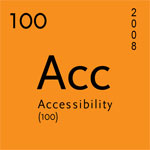Access is Everyone’s Business

With great anticipation, Accessibility 100 – a series of 100 easy-to-implement, free and inexpensive tips for improving accessibility for people with disabilities – launches today! Joining me for the kick off are Emese Szücs, Manager of Accessibility Programs, and Karen Thompson, Project Coordinator, from Social Planning and Research Council of British Columbia (SPARC BC) to discuss the upcoming Access Awareness Day on Saturday, June 7th, and how access is everyone’s business.
Welcome Emese and Karen!
Please share a bit about SPARC BC and the work it does.
SPARC BC is a registered non-profit society and has been a leader in research, public education, and consulting regarding issues of accessibility, social justice and community development for 42 years. With over 14,000 diverse members, we see and hear about what is important to people in BC communities.
Since 1984, SPARC BC has been providing the Parking Permit Program for People with Disabilities, allowing over 97,000 people in BC to stay connected to their communities and arrive safely to their destinations. SPARC BC has been actively advocating for accessibility issues since the early 70’s.

One of SPARC BC’s many accessibility initiatives is its Annual Access Awareness Day. What is the purpose behind this annual campaign?
Access Awareness Day is a province wide campaign to increase knowledge around accessibility issues and promote access and inclusion in BC communities. This year marks the 11th access awareness day!
This year’s theme is “Access Is Everyone’s Business!†What is this campaign about?
Access Is Everyone’s Business is meant to empower businesses with knowledge about how they can make their businesses more welcoming to customers with disabilities. The objective of the campaign is to inform business owners of simple things they can do to improve the experience of their customers with disabilities.
This year we are proud to be partnering with TransLink, BC Transit, VanCity ABLED Program, Shoppers HomeHealthCare, and the Better Business Bureau’s of Mainland BC and Vancouver Island to deliver this campaign across all of BC.
Why are you targeting the business community this year?
Canadians with disabilities contribute $25 billion in purchasing power. Improving the accessibility of businesses makes good sense, for economic and social reasons, especially with the 2010 Olympics and Paralympics coming to BC. Accessible design is also appealing for all consumers because all of us benefit from accessible features such as clear aisles, legible signage, and easy-to-open doors.
How can businesses participate?
A good first step for businesses would be to visit the SPARC BC website and check out the Access Awareness Day materials.
As part of our materials, we are excited to share a great banner that also serves as an information piece. It is packed with tips on simple things that businesses can do to make accessible and welcoming environments for all customers, no matter their abilities.
Businesses can also contact SPARC BC at 604.718.7733 or info@sparc.bc.ca and ask for an Access Awareness Day promotional kit.
How can individuals participate?
Individuals can support Access Awareness Day through becoming a SPARC BC member, and by contacting us and asking for a free Access Awareness Day pin. Wear your pin and start spreading the word! Tell someone you know about our resources available on our website.
What are five tips you’re hoping businesses will take away from this event?
- A wheelchair needs at least 36†or 91.5 cm to get through aisles, doors and hallways.
- A gradual slope and handrails are important. 1†of rise needs a ramp that is at least 12†long.
- Lever or loop style door handles are easier for persons with limited hand dexterity or upper body strength to use.
- Signage with high contrast colours and large typefaces are easier to read.
- Greet customers and ask if they would like assistance.
Thanks Emese and Karen for joining me today to kick off Accessibility 100. Wishing you a successful Access Awareness Day on Saturday, June 7th. Access is everyone’s business!
Accessibility 100 is a series of 100 easy-to-implement, free and inexpensive tips for improving accessibility for people with disabilities. This is a community project. Feel free to leave your comments, questions and ideas for future Accessibility 100 posts.
Get the entire series by subscribing to this blog by filling in the form in the upper right corner or by subscribing to the RSS feed.
If you enjoyed this post, consider buying me a chai tea latte. Thanks kindly.
 Subscribe via RSS
Subscribe via RSS



